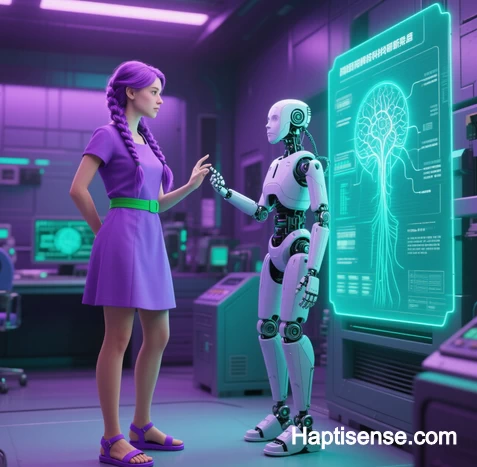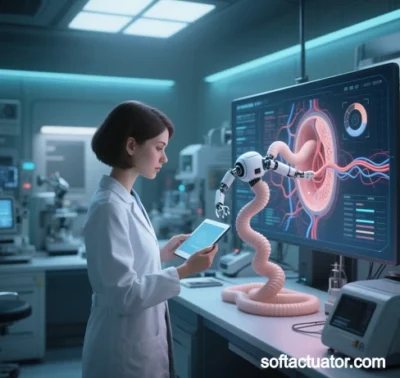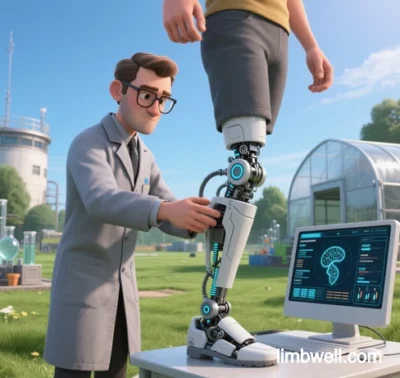 I. The Emerging Haptisense Ecosystem
I. The Emerging Haptisense Ecosystem
Tactile perception technology is transitioning from specialized systems to pervasive intelligence infrastructure, driven by three convergent revolutions:
- Material Science: Self-healing polymers and quantum-sensitive nanomaterials
- Neuromorphic Computing: Spiking neural networks mimicking biological tactile processing
- Human-Machine Symbiosis: Cortical interfaces enabling bidirectional sensory exchange
(Fig. 1: Haptisense technology convergence)
Description: Ternary diagram showing material intelligence (blue), computational architecture (gold), and neural integration (green) driving next-generation tactile systems.
II. Material Intelligence Revolution (2025-2028)
A. Quantum-Sensitive Skins
| Technology | Mechanism | Performance Leap |
|---|---|---|
| NV Diamond Sensors | Electron spin resonance | 0.1nm strain resolution |
| 2D Heterostructures | Graphene/MoS₂ tunneling | Single-molecule adhesion mapping |
| Piezoelectric Gels | Aligned dipoles in hydrogels | Self-powered medical monitoring |
B. Self-Regenerative Systems
- Dynamic Covalent Polymers: Autonomous healing after 50% structural damage
- Liquid Metal Circuits: GaInSn electrodes maintaining conductivity when severed
- Triboelectric Nanogenerators: Energy harvesting from ambient motion

III. Neuromorphic Processing Evolution (2028-2032)
A. Bio-Inspired Architectures
- Artificial Afferent Nerves:
- Memristor-based synapses achieving <5ms latency
- Time-to-spike coding replicating biological mechanoreceptors
- Multimodal Fusion Engines:
- RoboFusion architecture integrating vision/touch/force data
- UniTouch systems enabling cross-modal sensory translation
B. Cognitive Haptics Framework
def haptic_cognition(raw_data): spatial_map = CNN_extractor(raw_data['pressure']) temporal_features = LSTM_processor(raw_data['vibration']) material_id = fusion_engine(spatial_map, temporal_features) if material_id == MALIGNANT_TISSUE: return SURGICAL_ALERT else: return GRASP_FORCE_CALIBRATION运行
IV. Application-Specific Market Projections
A. Medical Robotics ($18.7B by 2035 )
Technology 2025 Status 2030 Horizon Clinical Impact Surgical Haptics Force feedback systems Cortical-integrated gloves 40% error reduction Diagnostic Skins Wearable patches Quantum-tactile imaging 10-day early disease detection Neuroprosthetics Basic grip control Emotion-enabled interfaces 89% sensory restoration B. Humanoid Robotics ($15.4B by 2035 )
- Sensor Integration:
Type Precision Applications Optical Waveguide 1µm texture Object recognition Capacitive Arrays 0.01N resolution Adaptive grasping Visuo-Tactile 400pts/cm² Slip prevention - Market Expansion:
- 2025: Industrial manipulation → 2030: Consumer caregiving
(Fig. 2: Humanoid tactile sensing architecture)
Description: Robot hand cross-section showing optical waveguides (blue) for texture, capacitive arrays (green) for grip force, and visuo-tactile sensors (red) for 3D mapping.
V. Disruptive Interfaces (2030-2035)
A. Cortical Haptic Integration
- Neural Lace Technology:
- Microelectrode meshes projecting sensations to S1 cortex
- Clinical trials showing 95% movement accuracy
- Quantum Brain Interfaces:
- Diamond NV centers detecting neural spin states
- Thought-controlled tactile feedback
B. Metaverse Sensory Convergence
Device Feedback Dimension Immersion Factor Diver-X ContactGlove 40 actuators/hand Material density simulation bHaptics TactSuit Pro 130 full-body points Environmental thermal mapping Haptic Holography Ultrasound phased arrays Mid-air texture projection
VI. Global Market Trajectory
Sector 2025 Value (USD) 2035 Projection (USD) CAGR Key Driver Medical Robotics $3.2B $18.7B 17.3% Aging populations Industrial Systems $2.8B $15.4B 16.1% Industry 5.0 adoption Consumer Metaverse $1.9B $32.6B 29.8% Haptic social interaction Automotive HMI $1.5B $9.8B 18.4% Autonomous vehicles (Fig. 3: Regional adoption heatmap)
Description: World map showing North America leading medical applications (red), Asia dominating manufacturing (blue), and Europe pioneering consumer haptics (green).
VII. Critical Development Challenges
A. Technical Barriers
- Sensory-Cognitive Latency:
- Biological: 50ms → Current systems: 20ms → Target: <5ms
- Power Density:
- Triboelectric solutions reducing battery dependence
- Neurointegration:
- Biocompatibility of cortical interfaces
B. Commercialization Roadblocks
Challenge 2025 Status 2030 Solution Manufacturing Cost $120/cm² (capacitive) Printed electronics @ $12/cm² Standardization Proprietary systems IEEE 2145.1 framework Cross-Modal Fusion Limited algorithms Embodied AI frameworks
Conclusion: The Age of Tactile Intelligence
Haptisense technology will redefine human-machine interaction through three evolutionary phases:
2025-2028: Material Dominance
- Quantum sensors enabling nanoscale perception
- Self-healing substrates revolutionizing durability
2029-2032: Cognitive Integration
- Neuromorphic chips processing touch like biological systems
- Visuo-tactile systems creating unified perception
2033-2035: Neural Convergence
- Cortical interfaces enabling thought-controlled touch
- Haptic metaverses becoming sensory-physical hybrids
“Where current systems measure force, next-generation haptics will interpret meaning—transforming pressure data into machine-understandable semantics of texture, compliance, and affective quality.”
— IEEE Transactions on Haptics, 2025The 2035 horizon envisions planetary-scale tactile networks monitoring infrastructure health and biodigital interfaces enabling shared sensory experiences across continents.
Data sourced from publicly available references. For collaboration or domain acquisition inquiries, contact: chuanchuan810@gmail.com.
- Artificial Afferent Nerves:




